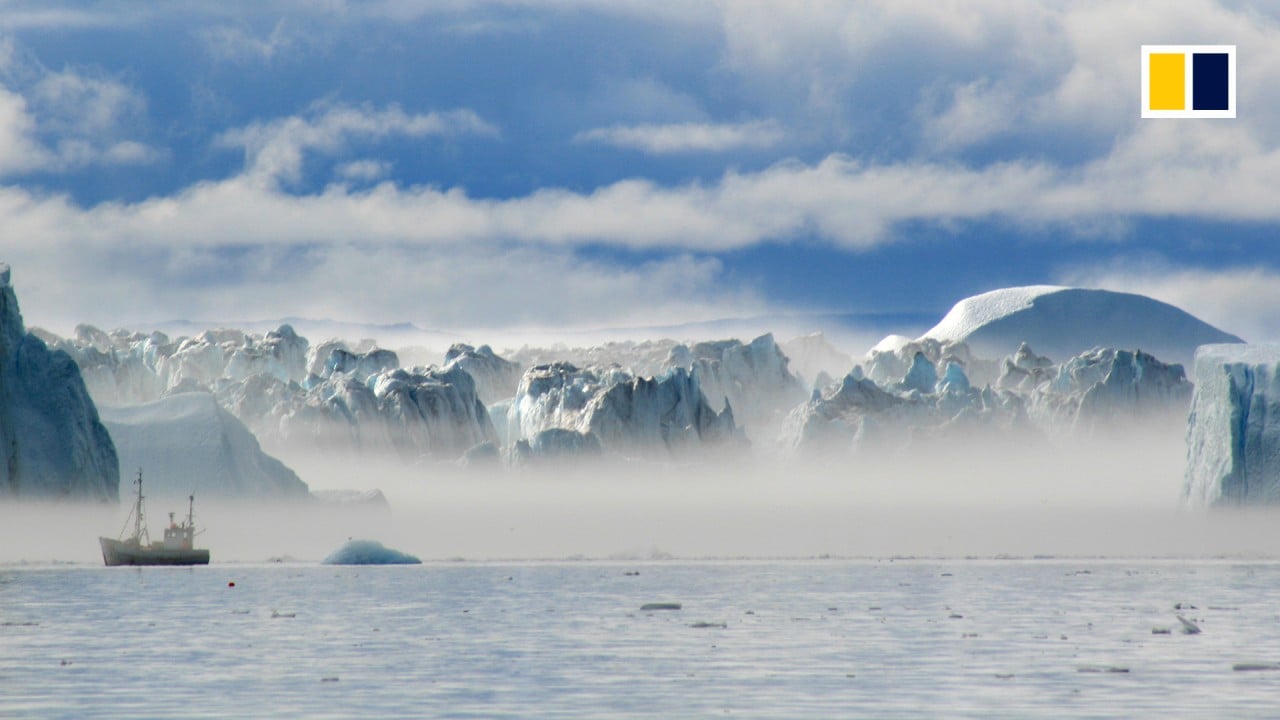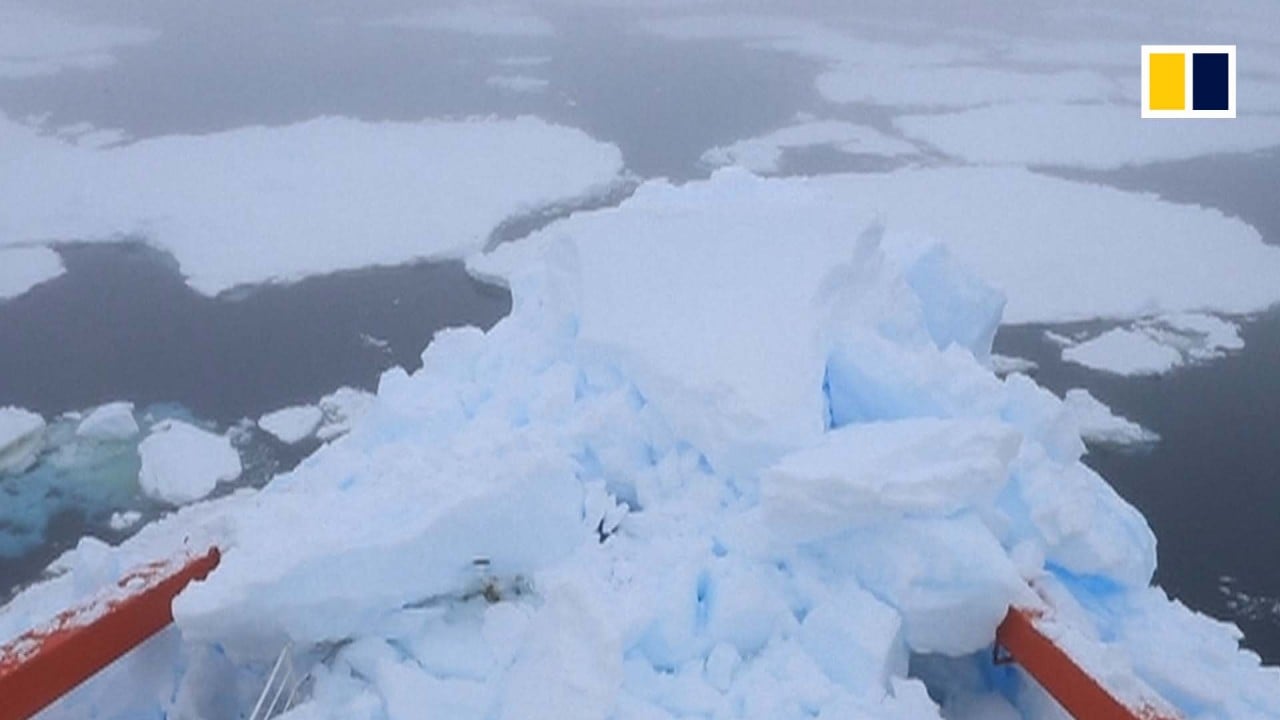
A more accessible Arctic becomes proving ground for US-China military jockeying
- The strategic importance of Alaska’s polar north is clear, as the US prepares for training exercises and China becomes more active in the Arctic region
- ‘China, Russia, the US – Alaska is in the middle of all of it,’ says former American intelligence officer
Over the next two weeks, US armed forces will crawl through, drive over, fly above and shovel into Alaska’s thawing tundra, training to defend this sparsely populated state from a power whose ambitions increasingly defy geography.
Some 10,000 uniformed service members from the Army, Navy, Air Force and Marines will participate in the Northern Edge training exercise aimed at countering China, Russia and other potential adversaries that threaten the Arctic frontier and broader Indo-Pacific region.
“China in the South China Sea continues to make territorial claims that are not recognised by the international community. We see that China’s using a series of abject intimidation, economic, coercion techniques to try and justify their territorial claims,” said Lieutenant General David Krumm, commander of Alaska Command and the Eleventh Air Force.
“We need to make sure that pattern is not repeated up here in the Arctic,” added Krumm, an Alabama native overseeing Northern Edge.

02:27
Russia wants to build up its Arctic route with China, its top diplomat to Beijing says
Locals say Washington is finally waking up to the strategic importance of Alaska, America’s largest state geographically and least densely populated, too often considered an afterthought by the “Lower 48”.
“Finally you’ve figured out this is an important place,” said Fran Ulmer, former Alaska lieutenant governor and chairwoman from 2011-2021 of the US Arctic Research Commission. “At least the US government has started paying more attention.”
A big wake-up call for Arctic nations Canada, Norway, Iceland, Denmark, Sweden, Finland, the US and Russia came in 2018 when China declared itself a “near-Arctic power” despite its location some 930 miles away. Ironically, China was an Arctic power until 1858 when the Qing empire conceded far northern territory to Russia, nine years before the US purchased Alaska, allowing it to join the club.
Few see China making a grab for territory outright. But money, trade, logistics, six research stations, an aggressive icebreaker-building programme, “plausible dual-use” research projects and an explicit long-term Arctic road map have done little to mask Beijing’s ambitions.
US admiral warns of risk of ‘bogus’ Chinese claims in Arctic
Even as China refers to the Arctic as a “global commons”, internal documents suggest a more strategic outlook, analysts said, as Chinese scholars posit that controlling the region would afford Beijing a “three continents and two oceans’ geographical advantage” over the Northern Hemisphere. In March, Beijing pledged to add a “Polar Silk Road” to its signature global infrastructure Belt and Road Initiative.
“China seeks to become a ‘polar great power’ but downplays this goal publicly,” the Brookings Institution said in a report last month.
A 2018 Chinese white paper outlined three objectives: to understand, protect and develop the Arctic, a region where the attraction is evident. Access to its natural resources could help power China’s economy. And rapidly melting ice from Alaska to Norway could halve freighter voyages to Europe and reduce vulnerability, underscored by the Suez Canal’s closure in March after a vessel ran aground.
“They’re very good at driving a long-term strategy,” said Cameron Carlson, founding director of the Homeland Security and Emergency Management programme at the University of Alaska, Fairbanks. “China’s been very astute, whether in Alaska or other parts of the Arctic, very good about inserting themselves.”

That includes embedding itself in major Arctic organisations, sending 33 high-level officials to the region since 2000, using scientific exploration to gain a foothold and mapping the seabed with its home-grown Xuelong 2 icebreaker.
On other fronts, China has sought control over infrastructure with potential military use, making plays to develop a large regional port and acquire a submarine base in Sweden; buy an old naval base and three airports in Greenland; and acquire 250 square kilometres (96.5 square miles) in Iceland for an airstrip and golf course “in an area where golf cannot be played”, Brookings said.
And in a now standard playbook, Beijing has used economic muscle to gain political leverage, ploughing billions into smaller Arctic nations and employing divide-and-conquer tactics – as seen, analysts said, when investments in Greenland fanned local hopes of independence from Denmark.
Greenland gears up for polls sparked by row over rare earths mining
“Once they have commercial, diplomatic and under-the-table payments, they build constituencies,” said Walter Skya, Asian studies director at the University of Alaska, Fairbanks. “You have to hand it to them, they are persistent.”
Beijing’s growing confidence and ambition befits its huge economy and global importance, Skya said. “But it tends to overreach, like a fat man at a buffet,” he added. “And over time, people don’t say ‘these Chinese are wonderful.’ Resentment tends to build up.”
China is hardly alone in attempting blatant land grabs, however. In 2019, then US president Donald Trump rather bizarrely offered to “buy” Greenland, a source of rare earth minerals used in everything from jet fighters to cellphone batteries, only to cancel a trip to Denmark in a huff after being rebuffed.
China’s own bid to exploit the island’s rich deposits were set back when a pro-environment party secured a plurality in parliament last month, pledging to halt mining.
Beijing is in many ways only doing what Western powers have long done, securing resources and trading routes for its population, said Ulmer, adding that demonising China could undermine US interests. “They’re people rich and resource poor,” she said. “The less the US wants to do with China, the more that China will do it with Russia.”

00:53
Chinese research icebreaker collides with an iceberg during Antarctic expedition
The heart of the Northern Edge exercise is at Joint Base Elmendorf-Richardson. Nearly a metre of snow and dense pine trees line the road leading from Anchorage into the Chugach Mountains above the base.
“This big base is [relatively] out of the range of our adversaries,” said Laura Sturdevant, an Alaska World Affairs Council board member and former US Air Force intelligence officer, pointing out Elmendorf-Richardson’s criss-crossing runways as a bald eagle soared overhead. “China, Russia, the US – Alaska is in the middle of all of it.”
Held every two years – with a complementary Arctic Edge exercise in alternate years – the May 3-14 Northern Edge includes up to 300 aircraft and personnel from around the Pacific. Details have not been released. But past scenarios – some including trained dolphins to help detect underwater intruders – sought to encourage role players to think creatively when confronting extreme weather, severed communications, nonexistent airstrips and limited cooperation between insular military branches.
Increasingly, the Pentagon has also leaned on unmanned technology to “patrol” Alaska’s vast reaches, including over-the-horizon polar radar, low-earth orbit satellites and fixed seabed surveillance.
China-Philippines Whitsun Reef dispute could get worse as US chips in
Also on its radar: how to defend against quasi-civilian “grey zone” tactics seen, for example, in China’s use of the coastguard and fishing fleets to harass and deter other nations who dispute its South China Sea claims, seen in March on the Philippines’ Whitsun Reef.
“The US absolutely will not and could not use our fishing fleets to impede on other countries in their economic zones. We would not do that. Yet we see China do it,” said Krumm. “What we don’t want is that mentality to come up here to the Arctic.”
Also worrying Washington is the spectre of Beijing and Moscow joining forces. While the two have a checkered history, their interests align in opposing democratic, human rights, market economic and rule of law values that threaten autocratic systems.
Russia has been President Xi Jinping’s most frequent foreign destination, and China’s share of Russian foreign trade rose to over 18 per cent in 2020 from 10 per cent in 2013. Russia’s reliance on Chinese funding for its Arctic infrastructure projects – including the port in Zarubino, a deep water port at Arkhangelsk and the Yamal LNG project – increased significantly after Moscow’s 2014 takeover of Crimea curtailed Western financing.

The two have also held joint military exercises in the Barents and North seas and eastern Siberia, and Moscow has stepped up sales of fighter jets, missile systems and an early warning anti-missile system to China. And in December, they flew joint bomber patrols over the Sea of Japan and East China Sea.
That said, significant fissures exist. China has advocated more multilateral control over the Arctic befitting its “near-Arctic” status while Russia, with the longest Arctic coastline and effective control over sea routes, considers itself the “Arctic superpower”.
Critics say the US is slowly waking up as American fishermen complain of aggressive Russian sorties over the Bering Sea, which at one point narrows to just 55 miles between the Alaskan and Russian coasts. Last year, US jets scrambled 14 times to counter Russian aircraft testing their defences, double the normal levels, said Krumm, and the most in nearly a decade.
America’s two Cold War-era icebreakers – compared with nearly four dozen for Russia, nine of which are nuclear – keep breaking down or catching fire; the Arctic was only recently incorporated into strategic planning; and the Pentagon still lacks a central Arctic coordinating office, analysts say.
China sends soldiers to Russia for snowy mountain challenge
Last year, US Coast Guard Commandant Admiral Karl Schultz called the situation “a woefully unacceptable level of presence in an area where we must be a leading force”.
So far, the Biden administration has largely maintained Trump’s Arctic policy, which last June called for three heavy icebreakers by 2029, four support bases and more focus on impeding China’s Arctic ambitions.
“Do we want the Arctic Ocean to transform into a new South China Sea, fraught with militarisation and competing territorial claims?” then secretary of state Mike Pompeo told the non-military Arctic Council in 2019, warning Russia and China against “aggressive” action.
One change is likely to be more focus on environmental issues, with Secretary of State Antony Blinken set to visit the next Arctic Council ministerial in Iceland on May 19-20.

To better handle another Exxon Valdez-type oil spill, vessel collision or other mishap, analysts have recommended closer US integration with allies to check Arctic militarisation and the construction of a northern deep water port around Nome, Alaska. Currently the closest strategic US port is 1,300 miles away.
“There’s going to be a tremendous amount of shipping, as much as 2,000 ships a year,” said Bill Walker, a lawyer and a former Alaska governor. “We need a response capability when the worst happens.”
Analysts also recommend that Washington focus on driving a wedge between Russia and China.
“China is not an Arctic nation, and it is in the US interest to limit China’s influence,” the Centre for a New American Security said in a recent report, citing the risk of an arms race. “There is no time to waste.”
Washington’s slow start compares with Moscow’s chest thumping. In recent years, it has strengthened airfields and restored Cold War-era Arctic military posts, including one on Wrangel Island a few hundred miles from Alaska’s coast, and last year drove its new nuclear-powered icebreaker to the North Pole.
One thing most agree on: as the economic and military stakes rise, the jockeying will only intensify.
“Alaska’s strategic importance is indisputable,” said Major Meg Harper of the North American Aerospace Defence Command and the US Northern Command. “The escalation of Russian activity and Chinese ambitions in the region demonstrates the strategic importance of the Arctic. Competition will only increase.”

